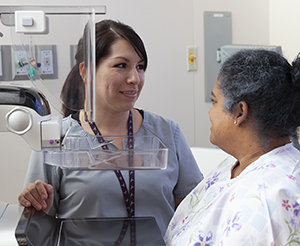A mammogram is an X-ray image of your breast tissue. It can help find problems with your breasts, such as cysts or cancer. A mammogram uses low-dose X-rays. It is the best breast cancer screening tool available.
Be proactive
Have mammograms and breast exams as often as your healthcare provider advises. Also, make sure you know how your breasts normally look and feel. This makes it easier to see any changes. Report changes to your provider as soon as you can. You must also check your insurance to know what's covered.
Types of mammography
-
X-ray. This uses low-dose X-rays to see breast tissue.
-
Digital. This uses electronics that convert X-rays into pictures of the breast. It uses less radiation.
-
Computer-aided detection (CAD). This looks for abnormal areas with an artificial intelligence (AI) method and marks them to be reviewed by a radiologist.
-
3-D mammogram (digital breast tomosynthesis or DBT). Images of the breast are taken from different angles to make a 3-D image.
How do I get ready for a mammogram?
-
Schedule the test for 1 week after your period. Your breasts are less sore and dense then.
-
Make sure your clinic gets images of your last mammogram if they were done somewhere else. This lets the provider compare the 2 sets of images for any changes.
-
On the day of your test, don’t use deodorant, powder, or perfume.
-
Wear a shirt that you can easily take off.
What to tell your healthcare provider
Tell your provider if:
-
You are pregnant or may be
-
You have breast implants
-
You have any scars or moles on or near your breasts
-
You had a breast biopsy or surgery
-
You are breastfeeding
What happens during a mammogram?
-
You will need to undress from the waist up and wear a hospital gown.
-
Remove any neck jewelry you are wearing.
-
You will stand in front of an X-ray machine. The technologist will help place your breast on the platform of the machine. They will position your breast as needed to get the best results.
-
Each breast will be pressed 1 at a time between the platform and a plastic panel. This helps get the most complete image.
-
Your breasts will be repositioned to get at least 2 views of each breast.
What happens after a mammogram?
-
Sometimes, more X-rays or an ultrasound are needed. If not done at the time of your mammogram, you will get a call to schedule them.
-
You should get your test results in writing. Ask when to expect the results.
-
You can go back to your normal activities right after the test.
Featured in


